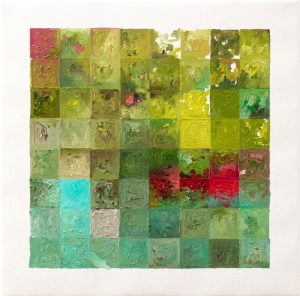
Kinga HAJDÚ
Hide-and-Seek
- Year(s)
- 2019
- Technique
- oil on canvas
- Size
- 50x50 cm
Artist's introduction
Kinga Hajdú studied painting at the Hungarian College of Fine Arts between 1985–89 and then participated in the same institution's Postgraduate Artist Training Program between 1989 and 1992. She has been an art teacher at the Hungarian College of Fine Arts' Secondary School of Visual Arts in Budapest since 1991. Kinga Hajdú emerged as a representative of the new generation in the second half of the 1990s, developing her painterly practice through conceptual and figurative means. The universe of these small-scale works relies on precision and a high degree of technical skill. Hajdú's first, invertedly executed paintings were quasi-naturalistic depictions of meat. The inspiration was provided by the meats' swirling structure, which she later developed as an independent motif. She went on to discover the abstract compositional possibilities inherent to the details of her paintings. In these images, she foreshadowed an artistic intention, which we witness in her later work: the importance of details seen through the lens of abstraction. The notions of figurativity and abstraction simultaneously define her artistic practice. Her compositions arranged according to a grid-like structure provide the polar opposite of her earlier circular compositions. While the circle represents the symbol of universal existence, the grid carries associations of finality, delineated areas and an earth-bound sense of gravity. The pictorial structures of Hajdú provide a platform for colour analysis as well. It is no coincidence that the artist is experimenting with earth tones in search of an overall sense of harmony. Júlia Fabényi
More artworks in the artist's collection »






